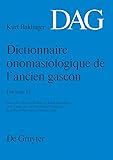Dictionnaire onomasiologique de l’ancien gascon (DAG). Fascicule 14 / Nicoline Winkler, Tiana Shabafrouz.
Material type: TextSeries: Dictionnaire onomasiologique de l’ancien gascon (DAG) ; Fascicule 14Publisher: Berlin ; Boston : De Gruyter, [2011]Copyright date: ©2011Description: 1 online resource (80 p.)Content type:
TextSeries: Dictionnaire onomasiologique de l’ancien gascon (DAG) ; Fascicule 14Publisher: Berlin ; Boston : De Gruyter, [2011]Copyright date: ©2011Description: 1 online resource (80 p.)Content type: - 9783110271836
- 9783110275377
- 447.77 23
- PC3426
- online - DeGruyter
| Item type | Current library | Call number | URL | Status | Notes | Barcode | |
|---|---|---|---|---|---|---|---|
 eBook
eBook
|
Biblioteca "Angelicum" Pont. Univ. S.Tommaso d'Aquino Nuvola online | online - DeGruyter (Browse shelf(Opens below)) | Online access | Not for loan (Accesso limitato) | Accesso per gli utenti autorizzati / Access for authorized users | (dgr)9783110275377 |
Browsing Biblioteca "Angelicum" Pont. Univ. S.Tommaso d'Aquino shelves, Shelving location: Nuvola online Close shelf browser (Hides shelf browser)
restricted access online access with authorization star
http://purl.org/coar/access_right/c_16ec
Le Dictionnaire onomasiologique de l’ancien gascon (DAG) est le premier dictionnaire qui se consacre spécifiquement au vocabulaire gascon médiéval. Trop souvent assimilé à l’occitan médiéval dans son sens global, l’ancien gascon est longtemps demeuré le grand inconnu de la diachronie gallo-romane. L’objectif du DAG est de présenter de façon onomasiologique l’inventaire lexical du plus ancien gascon depuis les origines de la langue écrite, au XIe siècle jusqu’à 1300 environ, période qui voit l’apparition des premiers textes littéraires. Le corpus est constitué de textes documentaires (chartes et textes de loi) formant une entité cohérente qui n'a pratiquement pas subi les influences du français, comme ce sera le cas aux siècles suivants. Le DAG nouvelle formule se présente désormais comme un dictionnaire plus concis, plus dense et plus tonique. Les nouveaux articles accordent davantage d’importance à la description sémantique et aux emplois en locution. L’ancienne citation profuse des contextes se limitera à un seul exemple. La simplification qui en découle procure un gain de lisibilité. Le fascicule no 12 poursuit les travaux onomasiologiques des fascicules 1 à 11 traitant de l’«univers» (partie A). Il amorce la section de l’homme (partie B) avec «L’homme, être physique» (B.I).
This dictionary of the Old Gascon language used in official documents deals with the lexis of South-Western France from the beginnings of written Gascon in the 11th century up to about 1300. The DAG is an onomasiological dictionary organising the vocabulary by subject groups. The emphasis is placed on the expressive means of medieval Gascon by bringing together all the words with related meanings. Thus apart from issues of pure word history, the dictionary also provides an insight into the structure of the lexis and thus into the linguistic and cultural history of a language domain. From Fascicle 12 onwards the DAG is being published with a new structure for the articles, which provides more scope for semantic description and phrases. Instead of giving a multiplicity of instances, in future one selected example will be provided for purposes of contextualisation, which will enhance readability.
Mode of access: Internet via World Wide Web.
In French.
Description based on online resource; title from PDF title page (publisher's Web site, viewed 17. Dez 2021)









